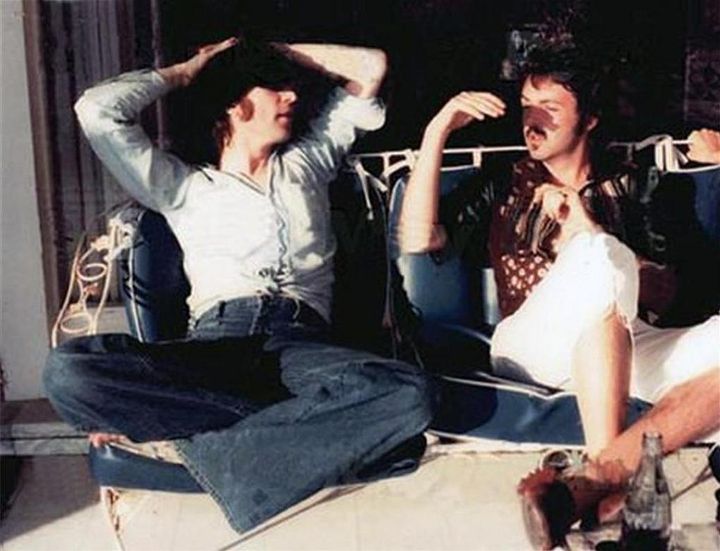
John Lennon and Paul McCartney, March 29, 1974
One of the saddest facts of John Lennon’s senseless murder in December 1980—and there are many, to be sure—is that his killer robbed him of the opportunity to grow old, to rethink his relationships and perspectives as we all inevitably do with the passage of time.
Yesterday marks the 41st anniversary of John and Paul’s last day together—the last day, at least, for which we have convincing historical evidence in the post-Beatles biographical record.
It was Saturday, April 24, 1976, when Paul and Linda McCartney were visiting John Lennon and Yoko Ono at the Dakota apartment building in New York City. It was a far cry from July 7, 1957—just shy of 19 years earlier—when John and Paul first met in a Liverpool churchyard.
As it turned out, that fateful evening in April 1976 was not the first time that Lennon and McCartney had crossed paths since the Beatles’ disbandment. The songwriting duo had previously reunited on March 29, 1974, during Lennon’s infamous Lost Weekend in Los Angeles. The last known photo of John and Paul was taken that day by May Pang at Lennon’s rented house in Santa Monica.
During the previous evening, the former bandmates had participated in an impromptu jam session with the likes of Stevie Wonder, Harry Nilsson, Jesse Ed Davis, and Bobby Keys in tow. Even Mal Evans, the Beatles’ longtime roadie, was there for the occasion. While the session made for a generally lackluster performance—rendered even worse, no doubt, by a range of licit and illicit substances—the surviving recording was later memorialized on the bootleg LP A Toot and a Snore in ’74.
But by April 1976, John and Paul’s lives had shifted yet again—and dramatically so, at that. Lennon had returned to hearth and home with Yoko at the Dakota, where they rounded out their family with six-month old baby Sean. As for McCartney, he had consolidated Wings’ success with the Band on the Run and Venus and Mars long-players and was preparing to embark on the North American leg of his Wings Over America tour, which had already proven to be a commercial juggernaut. On the night that he and Linda visited the Lennons in New York City, Wings at the Speed of Sound had just soared atop the US album charts.
While Lennon and McCartney would both recall the evening as being a convivial meeting of old friends, the proceedings took a turn for the surreal when the duo tuned into NBC’s latest installment of the comedy revue Saturday Night—later rechristened as Saturday Night Live—with Raquel Welch serving as guest host and John Sebastian as the show’s musical guest.
But it would be SNL’s vaunted producer, Lorne Michaels, who captured Lennon and McCartney’s attention—not to mention, the hearts and minds of a vast American television audience hungry for any hint of a potential Beatles reunion. Michaels didn’t mince words as he made his pitch, which was laden with tongue-in-cheek humor and irreverence, as with the finest SNL skits.
Remarking that “the Beatles are the best thing that ever happened to music,” Michaels invited the group to appear together on his show. “If it’s money you want, there’s no problem here,” the SNL producer joked. “The National Broadcasting Company has authorized me to authorize you a certified check for $3,000.”
“All you have do,” said Michaels, “is sing three Beatle tunes. ‘She loves you, yeah, yeah, yeah’—that’s $1,000 right there. You know the words, and it’ll be easy. Like I said, this check is made out to the Beatles. You divide it anyway you want: if you want to give Ringo less, that’s up to you.”
Unbeknownst to Michaels at the time, Lennon and McCartney were watching the proceedings as they unfolded just across town. And for a moment, they actually considered taking the SNL producer up on his offer. At one point, John turned to Paul, saying “we should go down, just you and me. There’s only two of us, so we’ll take half the money!” As McCartney later recalled, “We were having a night off, so we elected not to go. It was a nice idea. We nearly did it.”
And while the evening of April 24th was a joyous occasion for the old friends, it wasn’t always that way. During that same period, John later reported, “Paul just kept turning up at our door with a guitar. I would let him in, but finally I said to him, ‘Please call before you come over. It’s not 1956 and turning up at the door isn’t the same anymore. You know, just give me a ring.’ He was upset by that, but I didn’t mean it badly. I just meant that I was taking care of a baby all day and some guy turns up at the door.”
Years later, McCartney would remember their last words together with a special fondness, particularly in light of the ups and downs that they had experienced throughout the 1970s. The occasion was John’s 40th birthday on October 9, 1980, as Lennon and Ono prepared to release their Double Fantasy album.
“Fortunately for me,” Paul recalled, “the last phone conversation I ever had with him was really great, and we didn’t have any kind of blowup. It could have easily been one of the other phone calls, when we blew up at each other and slammed the phone down.” For McCartney, “it was just a very happy conversation about his family, my family. Enjoying his life very much. Sean was a very big part of it. And thinking about getting on with his career.”
And Paul would no doubt be buoyed by the comforting knowledge that he was in John’s thoughts in the twilight of his life. On December 8th, having just signed an autograph for the man who would lie in wait for him throughout the evening, Lennon hitched a ride to the Record Plant with RKO Radio’s Dave Sholin, who had interviewed John and Yoko that afternoon at the Dakota.
Being the consummate journalist, Sholin took advantage of the moment and asked Lennon about his relationship with McCartney. In those days, the press was rife with stories about the former Beatles being caught up in a kind of perpetual feud. But John didn’t miss a beat, telling Sholin that Paul was “like a brother. I love him. Families—we certainly have our ups and downs and our quarrels. But at the end of the day, when it’s all said and done, I would do anything for him, and I think he would do anything for me.”
The awful events of December 8, 1980, may have marked an end to the dream that the Beatles had unfurled upon the world, but for Paul that night could never diminish either the band’s achievement nor the friendship that they had shared across a lifetime. “There was some solace in the fact that we got back together,” McCartney recalled. “We were good friends. The story about the breakup, it’s true, but it’s not the main bit. The main bit was the affection.” It was real love.
Ken Womack is an internationally renowned Beatles authority regarding the band’s enduring artistic influence. His latest book, Maximum Volume: The Life of Beatles Producer George Martin (The Early Years: 1926-1966), is forthcoming in 2017. His previous Beatles-related books include Long and Winding Roads: The Evolving Artistry of the Beatles and The Beatles Encyclopedia: Everything Fab Four. You can learn more about Ken’s work at kennethwomack.com.
